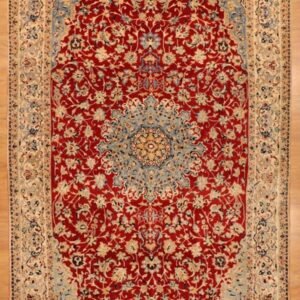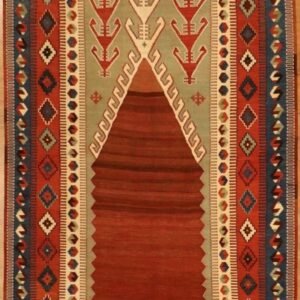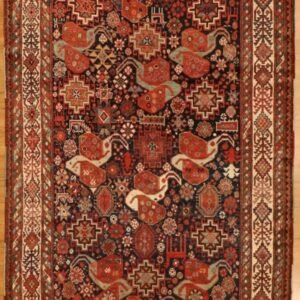Serial No.: 0009820
Origin: Caucasian, Azerbaijan
Town: Shirvan
Age: Late 19th Century
Style: Tribal Geometric with Unusual “Karagashli” Design and “S” Border
Size: 3’7″ x 5’4″
Material: Wool pile and wool foundation, vegetable dyed
Color Scheme: Red, Navy, Ivory
Condition: Excellent
Expert Description
This late 19th-century Shirvan rug is a distinguished example of Caucasian tribal weaving, notable for its “Karagashli” design elements and a striking “S” border. Hailing from the eastern reaches of Azerbaijan, it embodies the technical finesse and symbolic richness characteristic of Shirvan rugs, which were produced in small family workshops where weaving techniques and design vocabularies were passed down through generations.
Design & Motifs
The central field is organized around a large, stepped medallion flanked by complementary geometric forms. These motifs exhibit the hallmarks of Karagashli design—a substyle typically associated with bold central medallions, latch-hook edges, and complex internal detailing. In this piece, the sharp angles and layered structures create a visually dynamic composition set against a deep navy ground. The field is framed by an “S” border, a serpentine device often interpreted as a stylized dragon or protective symbol. Repeated around the perimeter, this border infuses the layout with a sense of motion and continuity.
Weaving Techniques & Materials
- Symmetrical Knotting (Turkish Knot): Consistent with Caucasian practice, the rug employs symmetrical knotting, yielding crisp outlines and durable construction.
- Wool Construction: Both the pile and foundation are crafted from local sheep’s wool. This choice ensures resilience, while the natural luster of the fibers enhances the depth of each color.
- Vegetable Dyes: The palette of red, navy, and ivory is achieved through regional dye materials—such as madder root for reds and indigo for blues. Over time, these natural pigments develop subtle tonal variations (abrash), further enriching the piece’s visual appeal.
Cultural & Historical Context
Located in eastern Azerbaijan, Shirvan was a renowned center of rug production throughout the 19th century. Its weaving tradition blended local motifs with influences from neighboring districts, fostering a rich tapestry of stylistic variations. The Karagashli substyle in particular drew praise for its bold geometric medallions and finely rendered details, while the “S” border references broader Caucasian symbolic themes, possibly linked to protective folklore or mythical creatures.
Artistic Significance
Preserved in excellent condition, this rug highlights the creative versatility of Shirvan weavers, who balanced the need for functional floor coverings with an appetite for aesthetic innovation. The unusual marriage of Karagashli medallions and the “S” border underscores the region’s ability to absorb and reinterpret various design influences, resulting in pieces that stand out for their originality and cultural resonance. Collectors and textile scholars prize such rugs for their historical importance, technical virtuosity, and capacity to convey the artistic narratives of 19th-century Caucasian weaving communities.







Reviews
There are no reviews yet.